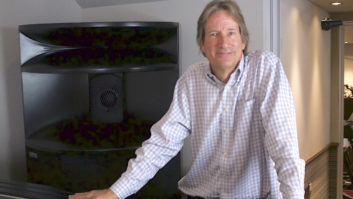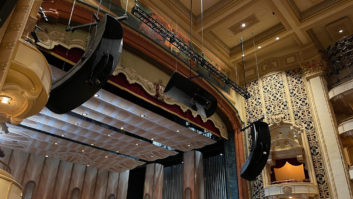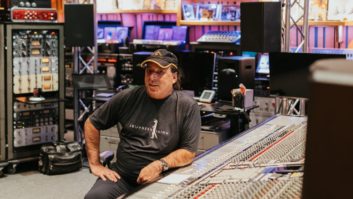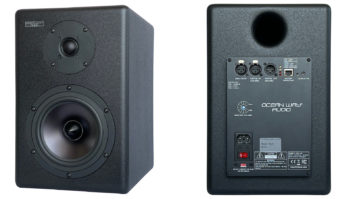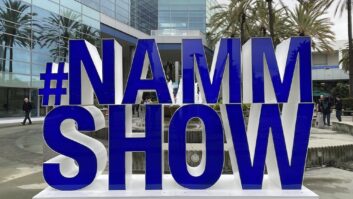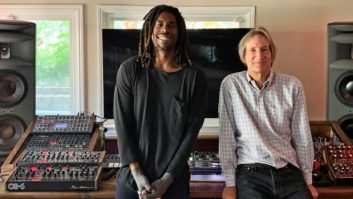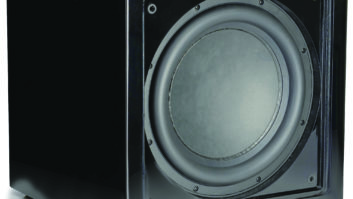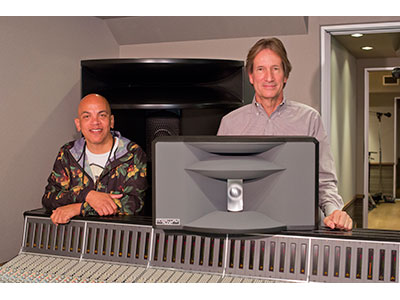
Ocean Way is the name of the street in Los Angeles where Allen Sides grew up. It’s where he first started experimenting with speaker designs in the early 1960s, in the garage, learning what made them sound the way they did. He would negotiate with theaters that were closing and buy the Altec A7s for pennies, haul them home and take them apart. He scoured for amps. He taught himself electronics and soldering and began to match components for optimum highs, mids and lows. He would visit Capitol and Warner Bros. through friends of friends to learn more about recording because he was also building a studio. He was 15.
Of course then Allen Sides went on to own and operate Ocean Way Recording, one of the world’s finest studios, for nearly 40 years. Later, the Ocean Way name would be franchised and branded, from Nashville to St. Barths, and there would be microphones and more studios and five Grammy Awards and a list of studio and live-to-broadcast engineering credits the envy of any engineer over the past years. He has one of those rare brains where the left and right halves work in harmony. He’s musical engineer, with the mind of a tinkerer. He’s also a shrewd businessman, dating back to when he would load up on cheap small candy items at home, then bring them to summer camp on Catalina Island. A Tootsie Roll is worth a lot to a kid on an island.
Then, about a decade ago, Sides started to slowly move away from the recording studio business. He sold off Ocean Way L.A., which he had purchased from mentor and friend Bill Putnam, and a few years back he sold Record One to Dr. Dre. The Ocean Way name remains in Nashville and St. Barths, and Sides remains an active producer and engineer, but for all practical purposes he was out of the studio business.
Still, this is a guy who runs up a 2,000-foot hill behind his Montecito home every morning, and remains an avid tennis player. He had no intention of sitting still, and so two years ago, he launched Ocean Way Audio. Back to designing speakers.
Sides has actually been designing speakers, audiophile and studio, his entire life and had already developed the Model HR2, the massive free-standing 3-way system, while still at Ocean Way. That provided his real introduction to pro audio. At last year’s AES Ocean Way Audio introduced the more affordable HR 4, a stunning near- to mid-field model that encapsulates all of his philosophies. There are also Pro 2As, the Montecito, the HR3 and the 4-way HR1, to go with mics sounds and all things audio. For the past few years he has been working with the legendary electro-acoustic designer Cliff Henricksen. He hired industry veteran Rick Plushner to run the operation.
So while there are a lot of topics that could be covered in an Allen Sides interview, a wealth of wisdom over five decades, here we talk about speakers. Starting with when he was 15 and building his first tri-amped systems with mix-and-match parts.

Sides with the Ocean Way Audio Pro 2a.
So this really did all start with speakers in a garage? Most kids picked up a guitar.
Well, I knew a hi-fi guy in the neighborhood, and one day he played me a Nelson Riddle Overture from Robin and the Seven Hoods. On vinyl. And Lee Hirschberg had recorded it in what would become my studio. And I thought, ‘Wow! This is amazing!’ And I remember being very young and seeing the Oscar Peterson Trio. Ray Brown. Listening to the way they sounded. How you as a musician make your instrument sound, that’s what I wanted to do with speakers.
I wanted these speakers I was building to sound a certain way, and I did all this experimentation until I got what I wanted. These were tri-amped. I had all these RCA, Western and Altec theater speakers to experiment with—every kind of crossover, the horn, the driver. I would pick a particular tube amp with a particular type of output tube. I liked the Marantz 9, which had a very low-distortion tube that sounded very good in the highs. But I didn’t like it in the bass. So I would use another amplifier on the low end, super fast, with 8-gauge welding wire to the woofer so I lost nothing in the line. But that 8-gauge wire did not sound good in the highs. I would optimize each amplifier for a specific range because I could. It’s my system. I would try four amps on my tweeter, crossing over at 10k and above. Which sounds the sweetest?
After a few years, as my speakers got better and better, I would
invite musicians back for playbacks, and that was my moment in time. I wanted them to be shocked. Harvey Mason, Nathan East, Greg Phillinganes—they would hear playback and say, ‘That is ridiculous!’ I live for that. If I have a joy, that’s what it is.
Ultimately, the end result is what matters. The process is not as relevant to me as the end result. I don’t mind being unorthodox. All I care about is what I hear at the end.

The Ocean Way Audio HR3.5.
So what do you want in a speaker?
What I’m looking for as an engineer and musician is a completely accurate reproduction of what I’m doing that has fantastic dynamic range. I like punch and impact, and when I’m mixing something I need to know that I have that. And it has to go low enough—even in a small speaker, at minimum down to 40Hz flat, for me to be happy with it and make an accurate judgment. I tend to like things a little bit bigger than life. And I can’t stand harsh sound.
The last thing I want is hype. I’m looking for something where I can hear into it in such a way that if I’m EQ’ing the bass or kick, or the inside mic and the outside mic, I need it to be accurate. I’m not really big on having subs somewhere else. I like all the arrival times to be together. I like super clarity, to hear the arrival times. All of our speakers, in general, are physically time aligned. So we don’t need to correct electronically; they’re aligned mechanically.
Also, I record digitally but I like to mix analog. The last thing I want is a digital speaker with a converter I wouldn’t even consider mixing through.
You have expressed a fondness for low end, and you played bass, What about the low end in your speakers?
The big problem is that subs and main speakers are often misaligned. It’s just about quantity, not definition. You have to match the mid-bass and low-bass components so that their transient performance and definition matches—so that the quality of the bass from 400 Hz down to 50 Hz is the same type of sound. The attack, if you hit a big bass note and pop it, all those frequencies arrive at the same time, with the same clarity. I’ve always been about, ‘It’s gotta be low and it’s gotta be tight.’ To get down to 40 in a small speaker is a big deal. And then my big system goes down to 18 Hz, almost entirely flat.
What else? Imaging? Depth?
On our HR2 and HR 3 systems, from a symmetry standpoint, typically I want my left and right speaker to be within 1 dB from 15 kHz to 400 Hz. I want them to be symmetrical, a little bit of equalization to be dead-on. Every single speaker we sell, we measure to determine if there are any flaws. It takes time, but I’m a perfectionist. Then you go to the room and make minor tweaks. We make a custom passive equalizer, with individual hand-wound toroids for every frequency. Super-simple analog signal path and ultra-fast slew rate. So we do have an EQ to calibrate for the space. It’s custom for every sale.
You mentioned dispersion earlier today.
The most important aspect to me and the one probably the most lacking in most studio speakers is how wide the dispersion is. Most speakers have pretty narrow dispersion and a small sweet spot. In a lot of conventional horns, the high frequency is no wider that the widest part of the throat before it expands. As the horn expands, the information below, say, 6k, conforms to the curve. The high frequency stays thin. It might be only 20 degrees of dispersion. To me, that’s almost useless.
If you use a waveguide with a very fast flare rate, you can linearize these differences and get very uniform dispersion over a fairly wide area. You also pick up efficiency and the dome doesn’t have to work as hard. If the waveguide is fast and the flare right, you don’t get that nasal quality. The better the dispersion, the less sound the horn has. So our HR2 has 120 degrees of horizontal dispersion, and you can measure the response at 0, and you can go 50 degrees off of 0 and it’s identical. To my knowledge, there’s no speaker that does that. You can walk around the room and it sounds great!

The Ocean Way Audio HR4.
You have introduced a whole range of speakers over the past two years. What else do you have planned?
Well, we’re right down the street from West Coast Custom in Burbank, and we’ve built some pretty cool large custom systems lately—Steve Aoki just got BMW blue.
And one of the speakers I’m working on is a replacement for line arrays that have 120-degree dispersion and incredibly low distortion. One of the problems when you’re sitting at, say, The Hollywood Bowl and you’re 20 seats off center, well, half the audience hears mono. With a speaker that can deliver 120 degrees, you can be in the far right row and hear everything. Cliff Henricksen is designing a system that does just that. The prototypes have been phenomenal. It’s a way to produce staggering levels with extremely low distortion. So there’s another approach, but we haven’t announced it yet.
